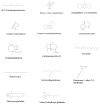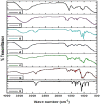Biological Evaluation, Phytochemical Screening, and Fabrication of Indigofera Linifolia Leaves Extract-Loaded Nanoparticles
- PMID: 35897890
- PMCID: PMC9369860
- DOI: 10.3390/molecules27154707
Biological Evaluation, Phytochemical Screening, and Fabrication of Indigofera Linifolia Leaves Extract-Loaded Nanoparticles
Abstract
Indigofera linifolia is a medicinally important plant, and by virtue of its rich phytochemical composition, this plant is widely used as essential component in traditional medication systems. Due to its wide range of medicinal applications, the extract-loaded chitosan (Ext+Ch), extract-loaded PEG (Ext+PEG), and extract-loaded locust bean gum (Ext+LGB) nanoparticles (NPs) were prepared in the present study. The prepared NPs were then evaluated for their antibacterial, antioxidant, and antidiabetic potentials. Antibacterial activities of the crude extract and the synthesized NPs were performed following standard procedures reported in the literature. The antioxidant capabilities of extract and NPs were evaluated using DPPH free radical scavenging assay. The antidiabetic potential of the samples was evaluated against α-amylase and α-glucosidase. Ext+PEG NPs showed more potent antibacterial activity against the selected strains of bacteria with the highest activity against Escherichia coli. The lowest antibacterial potential was observed for Ext+LGB NPs. The Ext+LGB NPs IC50 value of 39 μg/mL was found to be the most potent inhibitor of DPPH free radicals. Ext+LGB NPs showed a greater extent of inhibition against α-glucosidase and α-amylase with an IC50 of 83 and 78 μg/mL, whereas for the standard acarbose the IC50 values recorded against the mentioned enzymes were 69 and 74 μg/mL, respectively. A high concentration of phenolics and flavonoids in the crude extract was confirmed through TPC and TFC tests, HPLC profiling, and GC-MS analysis. It was considered that the observed antibacterial, antidiabetic, and antioxidant potential might be due the presence of these phenolics and flavonoids detected. The plant could thus be considered as a potential candidate to be used as a remedy of the mentioned health complications. However, further research in this regard is needed to isolate the exact responsible compounds of the observed biological potentials exhibited by the crude extract. Further, toxicity and pharmacological evaluations in animal models are also needed to establish the safety or toxicity profile of the plant.
Keywords: Indigofera linifolia; antidiabetic; antioxidant; nanoparticles.
Conflict of interest statement
The authors declare no conflict of interest.
Figures









Similar articles
-
Phytochemical Composition, Antibacterial, Antioxidant and Antidiabetic Potentials of Cydonia oblonga Bark.Molecules. 2022 Sep 26;27(19):6360. doi: 10.3390/molecules27196360. Molecules. 2022. PMID: 36234897 Free PMC article.
-
Efficacy of Euphorbia helioscopia in context to a possible connection between antioxidant and antidiabetic activities: a comparative study of different extracts.BMC Complement Med Ther. 2021 Feb 12;21(1):62. doi: 10.1186/s12906-021-03237-x. BMC Complement Med Ther. 2021. PMID: 33579270 Free PMC article.
-
Phytochemistry, Biological, and Toxicity Study on Aqueous and Methanol Extracts of Chromolaena odorata.ScientificWorldJournal. 2023 Oct 9;2023:6689271. doi: 10.1155/2023/6689271. eCollection 2023. ScientificWorldJournal. 2023. PMID: 37849963 Free PMC article.
-
Current Research of Phytochemical, Medicinal and Non-Medicinal Uses of Uncaria gambir Roxb.: A Review.Molecules. 2022 Oct 3;27(19):6551. doi: 10.3390/molecules27196551. Molecules. 2022. PMID: 36235088 Free PMC article. Review.
-
The Genus Anabasis: A Review on Pharmacological and Phytochemical Properties.Cardiovasc Hematol Agents Med Chem. 2025;23(1):11-28. doi: 10.2174/0118715257276051240111060414. Cardiovasc Hematol Agents Med Chem. 2025. PMID: 38258787 Review.
Cited by
-
Optimization of cationic nanoparticles stabilized by poloxamer 188: A potential approach for improving the biological activity of Aloeperryi.Heliyon. 2023 Nov 21;9(12):e22691. doi: 10.1016/j.heliyon.2023.e22691. eCollection 2023 Dec. Heliyon. 2023. PMID: 38125510 Free PMC article.
-
Screening of Tyrosinase, Xanthine Oxidase, and α-Glucosidase Inhibitors from Polygoni Cuspidati Rhizoma et Radix by Ultrafiltration and HPLC Analysis.Molecules. 2023 May 18;28(10):4170. doi: 10.3390/molecules28104170. Molecules. 2023. PMID: 37241909 Free PMC article.
-
Plant and marine-derived natural products: sustainable pathways for future drug discovery and therapeutic development.Front Pharmacol. 2025 Jan 6;15:1497668. doi: 10.3389/fphar.2024.1497668. eCollection 2024. Front Pharmacol. 2025. PMID: 39834812 Free PMC article. Review.
-
Synthesis and characterization of activated carbon-supported magnetic nanocomposite (MNPs-OLAC) obtained from okra leaves as a nanocarrier for targeted delivery of morin hydrate.Front Pharmacol. 2024 Oct 9;15:1482130. doi: 10.3389/fphar.2024.1482130. eCollection 2024. Front Pharmacol. 2024. PMID: 39444608 Free PMC article.
-
In vitro and in vivo evaluation of alginate hydrogel-based wound dressing loaded with green chemistry cerium oxide nanoparticles.Front Chem. 2023 Nov 23;11:1298808. doi: 10.3389/fchem.2023.1298808. eCollection 2023. Front Chem. 2023. PMID: 38075491 Free PMC article.
References
-
- Memariani Z., Abbas S.Q., Ul Hassan S.S., Ahmadi A., Chabra A. Naringin and naringenin as anticancer agents and adjuvants in cancer combination therapy: Efficacy and molecular mechanisms of action, a comprehensive narrative review. Pharmacol. Res. 2021;171:105264. doi: 10.1016/j.phrs.2020.105264. - DOI - PubMed
-
- Majid M., Farhan A., Asad M.I., Khan M.R., Hassan S.S.U., Haq I.-U., Bungau S. An Extensive Pharmacological Evaluation of New Anti-Cancer Triterpenoid (Nummularic Acid) from Ipomoea batatas through In Vitro, In Silico, and In Vivo Studies. Molecules. 2022;27:2474. doi: 10.3390/molecules27082474. - DOI - PMC - PubMed
MeSH terms
Substances
LinkOut - more resources
Full Text Sources
Miscellaneous

